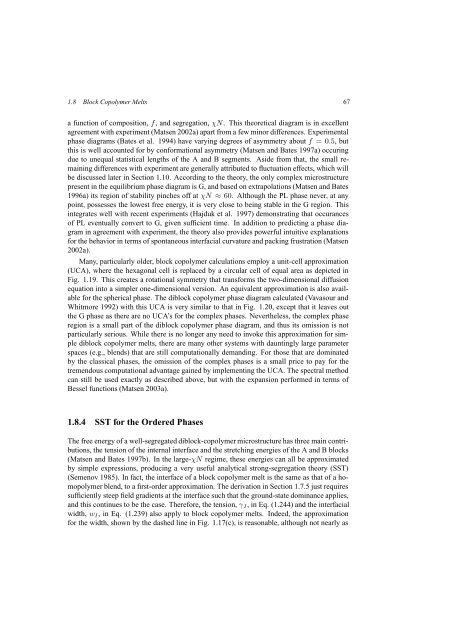Self-Consistent Field Theory and Its Applications by M. W. Matsen
Self-Consistent Field Theory and Its Applications by M. W. Matsen
Self-Consistent Field Theory and Its Applications by M. W. Matsen
You also want an ePaper? Increase the reach of your titles
YUMPU automatically turns print PDFs into web optimized ePapers that Google loves.
1.8 Block Copolymer Melts 67<br />
a function of composition, f, <strong>and</strong> segregation, χN. This theoretical diagram is in excellent<br />
agreement with experiment (<strong>Matsen</strong> 2002a) apart from a few minor differences. Experimental<br />
phase diagrams (Bates et al. 1994) have varying degrees of asymmetry about f =0.5, but<br />
this is well accounted for <strong>by</strong> conformational asymmetry (<strong>Matsen</strong> <strong>and</strong> Bates 1997a) occuring<br />
due to unequal statistical lengths of the A <strong>and</strong> B segments. Aside from that, the small remaining<br />
differences with experiment are generally attributed to fluctuation effects, which will<br />
be discussed later in Section 1.10. According to the theory, the only complex microstructure<br />
present in the equilibrium phase diagram is G, <strong>and</strong> based on extrapolations (<strong>Matsen</strong> <strong>and</strong> Bates<br />
1996a) its region of stability pinches off at χN ≈ 60. Although the PL phase never, at any<br />
point, possesses the lowest free energy, it is very close to being stable in the G region. This<br />
integrates well with recent experiments (Hajduk et al. 1997) demonstrating that occurances<br />
of PL eventually convert to G, given sufficient time. In addition to predicting a phase diagram<br />
in agreement with experiment, the theory also provides powerful intuitive explanations<br />
for the behavior in terms of spontaneous interfacial curvature <strong>and</strong> packing frustration (<strong>Matsen</strong><br />
2002a).<br />
Many, particularly older, block copolymer calculations employ a unit-cell approximation<br />
(UCA), where the hexagonal cell is replaced <strong>by</strong> a circular cell of equal area as depicted in<br />
Fig. 1.19. This creates a rotational symmetry that transforms the two-dimensional diffusion<br />
equation into a simpler one-dimensional version. An equivalent approximation is also available<br />
for the spherical phase. The diblock copolymer phase diagram calculated (Vavasour <strong>and</strong><br />
Whitmore 1992) with this UCA is very similar to that in Fig. 1.20, except that it leaves out<br />
the G phase as there are no UCA’s for the complex phases. Nevertheless, the complex phase<br />
region is a small part of the diblock copolymer phase diagram, <strong>and</strong> thus its omission is not<br />
particularly serious. While there is no longer any need to invoke this approximation for simple<br />
diblock copolymer melts, there are many other systems with dauntingly large parameter<br />
spaces (e.g., blends) that are still computationally dem<strong>and</strong>ing. For those that are dominated<br />
<strong>by</strong> the classical phases, the omission of the complex phases is a small price to pay for the<br />
tremendous computational advantage gained <strong>by</strong> implementing the UCA. The spectral method<br />
can still be used exactly as described above, but with the expansion performed in terms of<br />
Bessel functions (<strong>Matsen</strong> 2003a).<br />
1.8.4 SST for the Ordered Phases<br />
The free energy of a well-segregated diblock-copolymer microstructure has three main contributions,<br />
the tension of the internal interface <strong>and</strong> the stretching energies of the A <strong>and</strong> B blocks<br />
(<strong>Matsen</strong> <strong>and</strong> Bates 1997b). In the large-χN regime, these energies can all be approximated<br />
<strong>by</strong> simple expressions, producing a very useful analytical strong-segregation theory (SST)<br />
(Semenov 1985). In fact, the interface of a block copolymer melt is the same as that of a homopolymer<br />
blend, to a first-order approximation. The derivation in Section 1.7.5 just requires<br />
sufficiently steep field gradients at the interface such that the ground-state dominance applies,<br />
<strong>and</strong> this continues to be the case. Therefore, the tension, γ I , in Eq. (1.244) <strong>and</strong> the interfacial<br />
width, w I , in Eq. (1.239) also apply to block copolymer melts. Indeed, the approximation<br />
for the width, shown <strong>by</strong> the dashed line in Fig. 1.17(c), is reasonable, although not nearly as
















